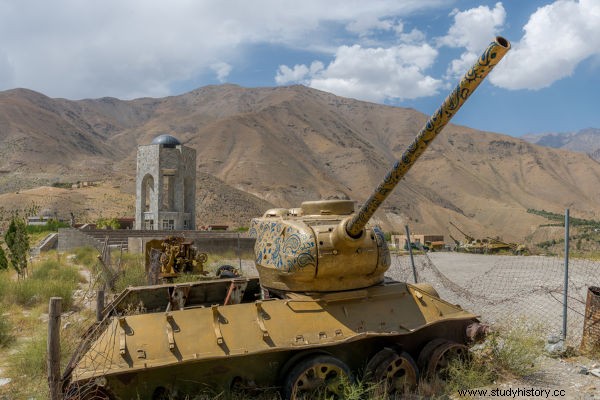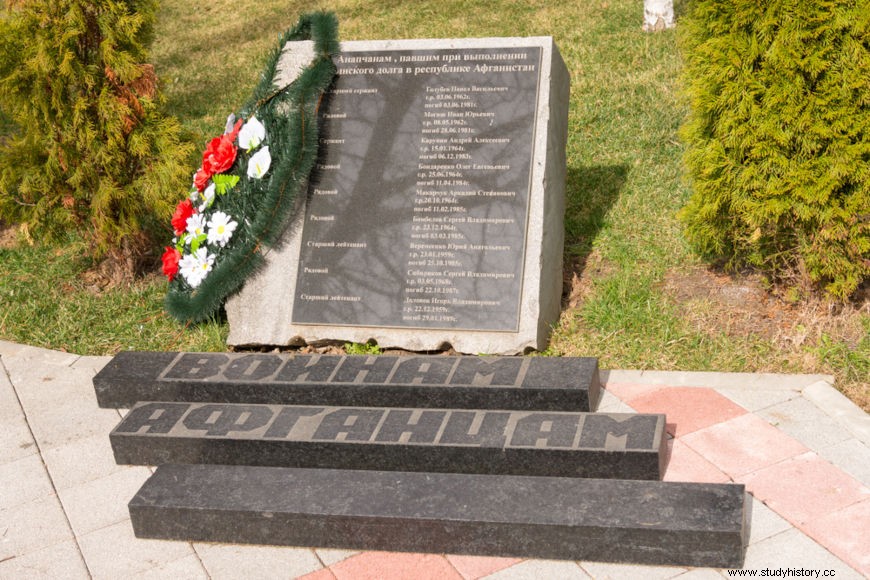
The Afghan War of 1979 was a conflict that began when the Soviet Union decided to invade Afghanistan to defend the communist government that had ruled the country since 1978. In the struggle, the Soviets faced the mujahidin , rebels who did not agree with the communist government. The mujahidin received US support and managed to force the Soviets out 10 years later.
Go to also :Cold War, the context that influenced the beginning of several conflicts in the 20th century
Afghan War Summary
- In 1978, the Communists seized Soviet power in a coup known as the Saur Revolution.
- The reforms promoted by the communists displeased part of the Afghan society, and revolts began to happen in the country.
- The mujahidin were funded by the United States and other countries such as Saudi Arabia.
- To protect the communist government of Afghanistan and prevent the Afghan example from spreading, the Soviet Union decided to invade the country in December 1979.
- The Soviets fought in Afghanistan for 10 years, but were unable to conquer the country, and withdrew in 1989.
Video Lesson on the War in Afghanistan
Background to the War in Afghanistan
In 1973, a coup was carried out in Afghanistan and the country's monarchy was replaced by the republican regime. This coup was led by Mohammad Daoud , who became president of Afghanistan from then on. Daoud had been the country's prime minister during the 1950s and had a good relationship with the communists.
However, from his presidency onwards, he began to promote a series of actions to remove communists from politics and from positions in the Afghan government. Afghan communists gathered in the Afghan People's Democratic Party (PDPA). In addition, Daoud sought to approach Iran and Saudi Arabia, Islamic and conservative nations.
Daoud's persecution and his rapprochement with neighboring nations made the communists begin to conspire against the president. This conspiracy gave rise to a coup which began on April 27, 1978. This event was named Saur's Revolution and, according to historian Gregory Fremont-Barnes, there was no Soviet involvement.|1|
[advertising-omnia]
Still, once the communist regime was installed in Afghanistan, the Soviet government was open to cooperation. Under the PDPA government, a series of drastic reforms began to be implemented in this Asian country. These changes ended up dividing Afghan society, which paved the way for war.
First, the PDPA started a campaign to repress opponents as a way of sustaining power and promoted reforms in women's rights and the land issue. A reform agrarian was initiated in the country, expropriating land that belonged to large landowners and giving it to peasants.
In addition, the communists began a process of secularization of Afghan society and they decided to end religious laws, limit the operation of mosques and abolish the Muslim veil. Other significant changes were with regard to women's rights , giving them the right to choose who to marry and be educated.
All these changes promoted by the communists displeased a significant part of the extremely conservative and religious Afghan society. This situation led to the start of a series of riots of the population against the PDPA government. The communist government's repression of these uprisings caused opposition to the party to grow in Afghanistan.
Afghan religious leaders have started calling on the population for a jihad , a holy war against the communists, accused of being atheists and anti-Muslims. It was in this context that the United States began to intervene in the Afghan situation.
The US government, at the time led by Jimmy Carter , identified in the Afghan crisis an excellent opportunity to weaken the Soviets. The US government, in July 1979, began to finance some of the rebel groups that appeared in Afghanistan, the mujahideen .
The purpose of the US government in this was to trap the Soviet government and get it to invade Afghanistan to save the communist government of the PDPA. The United States hoped that Afghanistan would become the “Soviet Vietnam” and that it would contribute to affect the Soviet economy.
Login also :Ronald Reagan, the president who invested massively in the mujahideen
Main Events of the War in Afghanistan
The Soviet government became concerned about the mujahideen rebellions , first because they wanted to maintain a satellite state in Central Asia. Furthermore, the Soviet feared that a conservative and Islamic uprising in Afghanistan could spread to territories of the Soviet Union that bordered Afghanistan and that had a significant Muslim population, as in the cases of Uzbekistan, Tajikistan and Turkmenistan.
Throughout 1979, opposition from the mujahidin became more powerful and put the PDPA government at risk. This caused the government of Leonid Brezhnev to intervene in the situation in Afghanistan, and the invasion of the country took place on December 24, 1979 , that was the beginning of the War in Afghanistan.
The Soviet invasion of Afghanistan spanned 10 years, and in that period, the mujahidin used guerrilla tactics against invaders. The mountainous terrain of part of the Afghan territory was perfect for guerrilla warfare and hindered the performance of Soviet armor and artillery.
The mujahidin made heavy use of the element of surprise , that is, they made unexpected attacks with great intensity and then withdrew quickly. The troops of the mujahideen they rarely promoted conflict with open confrontation, and when they felt threatened, they did not hesitate to flee. Finally, they had a great knowledge of the terrain and preferred night combat.
There was a great adhesion of the population to the fight against the Soviets , and Gregory Fremont-Barnes points out that it was common for 12-year-olds to participate in the fight alongside their parents and grandparents.|2| Most mujahidin fought motivated by the call of the jihad , the holy war, the fight against the Soviet atheists.
Throughout the conflict, the mujahidin they had no great air attack force or great artillery. They armed themselves, to a large extent, with Kalashnikovs that were obtained by the funding they received from the United States, Saudi Arabia, Iran, among others. Still, at the end of the war, the mujahidin they also had anti-aircraft equipment.
After invading Afghanistan, the Soviets controlled a strategic road that linked the Soviet border to Kabul, as well as a few major cities. They also sought to attack a region known as the Panjshir Valley, but failed. In much of Afghan territory, the Soviet presence was non-existent or minimal.
In general, the results obtained by the Soviet troops were poor. The Soviet army was accumulating failures in Afghanistan and had difficulties in dealing with the Afghan geography and the great resistance of the mujahadin . The Soviets also adopted the tactic of bombing villages and plantations that were in the vicinity of areas where the guerrillas were active.
Over time, the war became very costly for the Soviet Union , as the number of soldiers who died became very large and the costs of the conflict were very high. Until 1987, for example, the Soviet Union had already spent about 50 billion dollars on it.|3| The Soviets decided to withdraw completely from Afghanistan in 1989 .
Login also :Vietnam War and the American Defeat
Consequences of the War in Afghanistan

The 1979 Afghan War began to a process of destabilization of Afghanistan , which continues to this day. This conflict contributed to destroying the country's infrastructure and increasing its level of poverty. Furthermore, the War in Afghanistan served as a starting point for the strengthening of Islamic fundamentalism.
The mujahidin , were largely funded by the United States and were heavily influenced by extremist ideals exported from Saudi Arabia. As a result, Islamic fundamentalism developed in Afghanistan, and important names such as Osama bin Laden , took part in this conflict. Bin Laden is known to have been one of the founders of Al-Qaeda and one of the architects of the 9/11 attacks.
Ultimately, this scenario of religious fundamentalism allowed the Taliban to develop in the country in the 1990s. The group emerged during the civil war scenario that settled in the country.
The Civil War was consolidated after the defeat of the PDPA, in 1992. With the departure of the Soviets, the PDPA continued the fight against the mujahideen , but in 1992 it was defeated and a new government was formed. The new government continued to struggle, as there were mujahideen groups who wanted the power to impose a fundamentalist regime. One of these groups was the Taliban themselves.
Finally, the conflict contributed to intensifying the economic crisis that hit the Soviet Union in the 1980s. The Soviet economic crisis was fundamental to the failure of the Soviet model and the country's dissolution in 1991. It is estimated that up to 1.5 million Afghans may have died in this conflict.
-
Taliban and the resumption of power in Afghanistan
Notes
|1| FREMONT-BARNES, Greogry. The Soviet-Afghan War 1979-89 . Oxford:Osprey Publishing, 2012. p. 32.
|2| Ditto, p. 28.
|3| The Costs of Soviet Involvement in Afghanistan. To access, click here [in English].
Image credits
[1] Madhourse and Shutterstock
